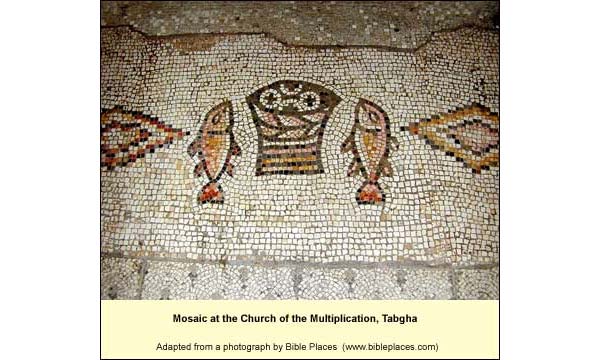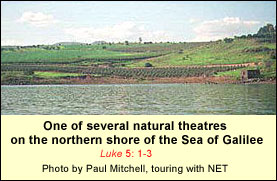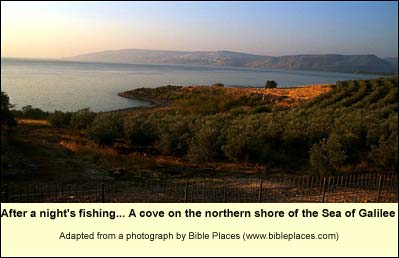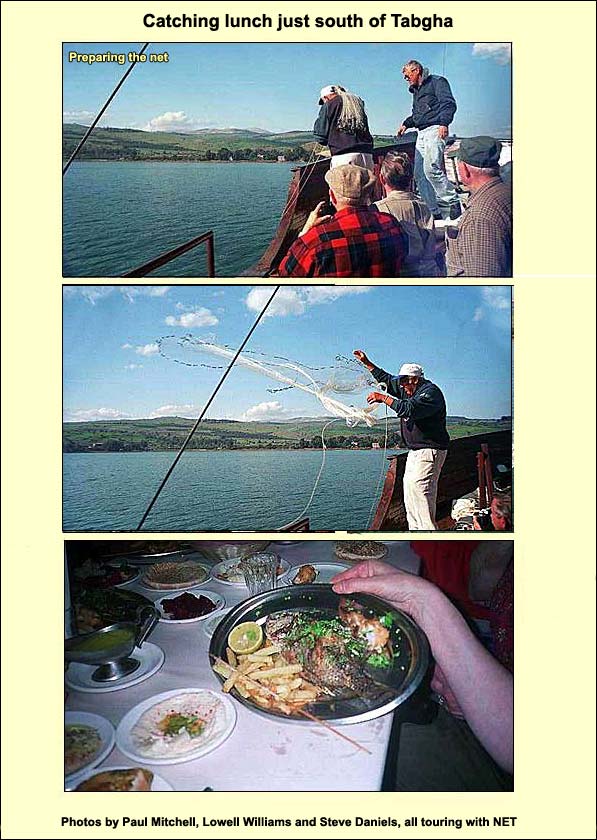Tabgha
Ancient traditions of Jesus are preserved in two churches at Tabgha:
Church of the Multiplication of Loaves and Fishes
The church contains fifth-century mosaics. According to Jerome Murphy-O'ConnorJerome Murphy-O'Connor, The Holy Land: An Archaeological Guide, 4th edition. London: Oxford, 1998 (p. 278) this is the earliest-known figural pavement in Palestinian church art. Most of it consists of graceful scenes from the Nile, which were popular throughout the ancient world: ducks on bell-like lotus blossoms, a battle between a goose and a snake, the Nilometer (a slim tower for measuring the height of the Nile at flood, in order to determine the height of expected prosperity and hence that of taxes). One mosaic was made specifically for this church: at the foot of the altar are two fish and four loaves of bread. Why only four? The idea, perhaps, was that the fifth would be on the altar.


Logistics: As of March 2019, the church keeps regular hours on weekdays (0800-1645), but closes at 14:45 on Saturday and opens at 11:00 on Sunday: Phone: 04-6678100. Modest dressShoulders covered, legs covered below the knees required). Church of the Primacy of Peter Just east of the Multiplication church is the Franciscan Church of the Primacy of Peter (open 8.00 - 17.00; modest dress required). Phone: 04-6724767. For at least 1600 years, Christians have remembered here another feeding: the post-resurrection breakfast that Jesus baked for his disciples. They had gone back to being fishers of fish, and from here he sent them out again to be fishers of men. One may begin with Luke 5, his first meeting with Peter, and then proceed to the breakfast in John 21. Why breakfast? Because they usually worked at night, when the fish couldn't see the nets.

On the shore or in the water, depending on season and year, lie six heart-shaped stones, each accommodating two persons. These "thrones of the apostles" were segments of a pillar at the corner of a basilica. Beside them are steps carved into the rock. Egeria saw them too: "Not far away from there (Capernaum) are some stone steps where the Lord stood." Inside the modest basalt church is another table-like basalt boulder, in better shape than its neighbor at the Multiplication. Between these two churches, on the north side of the modern road, appear the ruins of yet another: the original Church of the Beatitudes. Here the Byzantines located the sermon. Here too we have help from Egeria: "Past the walls of this church (of the Multiplication) goes the public highway on which the Apostle Matthew had his place of custom. Near there on a mountain is the cave to which the Saviour climbed and spoke the Beatitudes." The cave is probably the one on the same slope a bit to the east.
